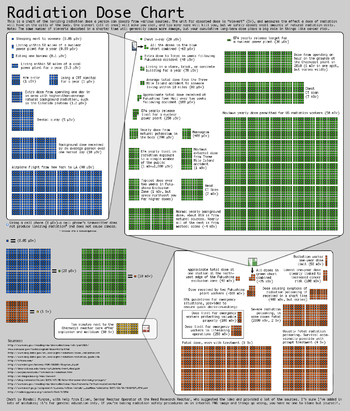Radiation Hazards: Difference between revisions
imported>Jess Brewer mNo edit summary |
imported>David MacQuigg No edit summary |
||
| Line 2: | Line 2: | ||
{{seealso|Nuclear_power_reconsidered}} | {{seealso|Nuclear_power_reconsidered}} | ||
{{Image|XKCD Radiation Chart.png|right|350px|Fig.1 Handy chart from [http://xkcd.com/radiation xkcd.com] compares radiation doses.}} | {{Image|XKCD Radiation Chart.png|right|350px|Fig.1 Handy chart from [http://xkcd.com/radiation xkcd.com] compares radiation doses.}} | ||
{{Image|Electrify5Radiophobia.009.jpeg|right|350px|Add image caption here.}} | |||
One of the primary obstacles to nuclear power is the public's fear of ''radiation''. While ionizing radiation can certainly be dangerous at high doses, because most people have difficulty distinguishing between a ''little'' and a '''lot''', this has often been oversimplified to, "The only acceptable amount of radiation is ''zero''!" That goal can never be met, since (for example) all living things are radioactive. A sensible criterion must be based on an understanding of where radiation comes from, what sorts of damage radiation ''does'', and how much radiation it takes to ''do'' it.<ref>[https://jick.net/skept/RadHaz/RadHaz_talk.pdf Lecture on Radiation Hazards] Jess H. Brewer</ref> | One of the primary obstacles to nuclear power is the public's fear of ''radiation''. While ionizing radiation can certainly be dangerous at high doses, because most people have difficulty distinguishing between a ''little'' and a '''lot''', this has often been oversimplified to, "The only acceptable amount of radiation is ''zero''!" That goal can never be met, since (for example) all living things are radioactive. A sensible criterion must be based on an understanding of where radiation comes from, what sorts of damage radiation ''does'', and how much radiation it takes to ''do'' it.<ref>[https://jick.net/skept/RadHaz/RadHaz_talk.pdf Lecture on Radiation Hazards] Jess H. Brewer</ref> | ||
Revision as of 12:16, 19 January 2022
- See also: Nuclear_power_reconsidered

One of the primary obstacles to nuclear power is the public's fear of radiation. While ionizing radiation can certainly be dangerous at high doses, because most people have difficulty distinguishing between a little and a lot, this has often been oversimplified to, "The only acceptable amount of radiation is zero!" That goal can never be met, since (for example) all living things are radioactive. A sensible criterion must be based on an understanding of where radiation comes from, what sorts of damage radiation does, and how much radiation it takes to do it.[1]
Figure 1 compares a range of radiation exposures, from the dose received from sleeping next to another human (0.05 Sv) to the usually fatal dose of 4 Sv, a hundred million times greater.
Notes and References
- ↑ Lecture on Radiation Hazards Jess H. Brewer

